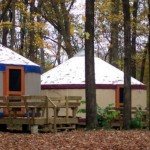 Yurts were created in Mongolia long before our economy crisis. In fact yurts accommodated nomadic people for thousands of years. Especially in the past 25 years, there’s been a resurgence of interest. Then manufacturers began creating their own design modifications for a variety of purposes.
Yurts were created in Mongolia long before our economy crisis. In fact yurts accommodated nomadic people for thousands of years. Especially in the past 25 years, there’s been a resurgence of interest. Then manufacturers began creating their own design modifications for a variety of purposes.
The purpose of constructing a yurt may be for a home, office, store, workshop, rental, or vacation lodge. The yurt design may include a loft, be surrounded by a large deck, or be a two-story structure. It can be permitted to satisfy building codes, temporary, or off the grid. What’s really fascinating is how many climates a yurt is feasible to be comfortable in.
Whatever the purpose, it’s a good idea to learn the history of yurts. Yurtinfo.org is an ideal educational site created by author of Living in the Round, Becky Kemery. She provides a world of information and inspiration dedicated to helping people make yurt decisions.
 Modern material examples are steel aircraft cable and architectural fabrics. Although weather makes nontoxic durability a challenge at every distance from the equator, fabric choices are expanding. Expect to see more options soon, and from a combination of plant-based or recycled fibers with modern technology.
Modern material examples are steel aircraft cable and architectural fabrics. Although weather makes nontoxic durability a challenge at every distance from the equator, fabric choices are expanding. Expect to see more options soon, and from a combination of plant-based or recycled fibers with modern technology.
Be prepared to be connected with nature in such a unique way that it’s difficult to describe. Keywords are simplicity and sustainability.
 Whether you select an ancient or modern yurt design, the practicality spells affordable and the lifestyle is in harmony with our planet.
Whether you select an ancient or modern yurt design, the practicality spells affordable and the lifestyle is in harmony with our planet.
I moved into my yurt only three months ago and am anxious to write about the phases of yurt construction and living. Photos posted herein are provided by Yurts of Hawaii. Stay tuned for more and please feel free to share your experiences. I invite you to add a comment or question below.
RELATED POST:
Live in a Well Rounded Dwelling and Build a Yurt Outside


2 Comments